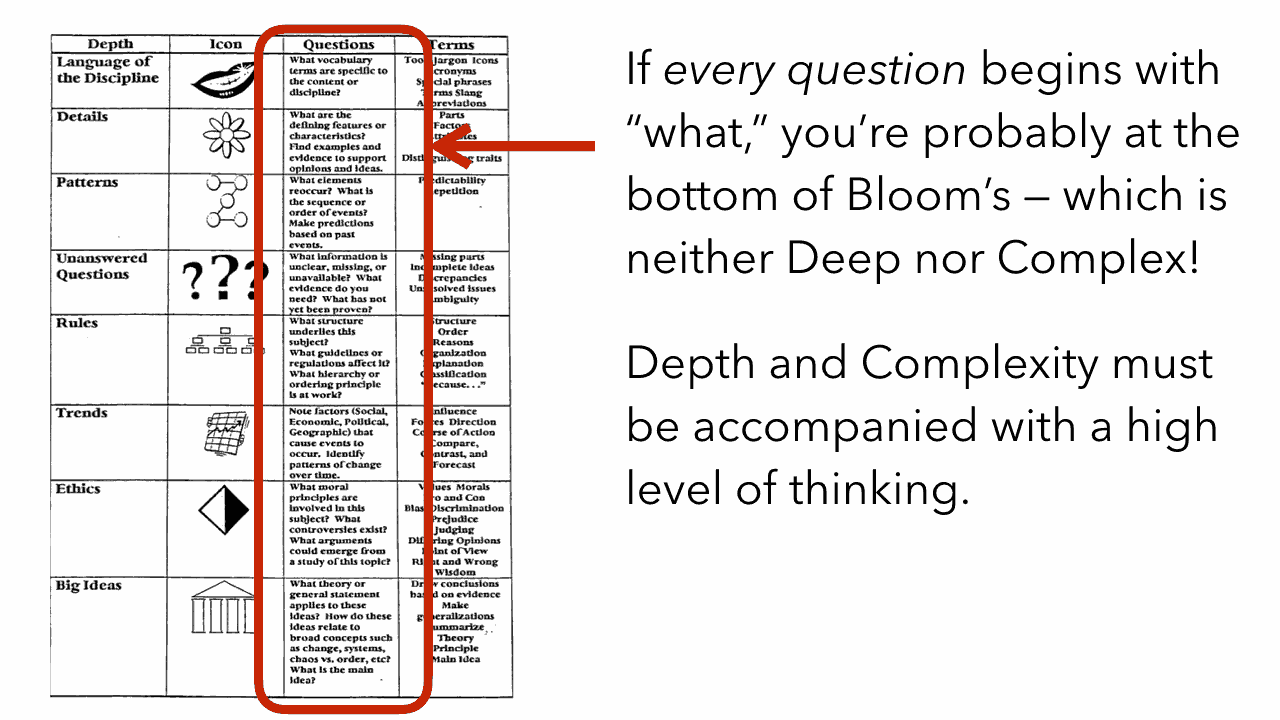The prompts of depth and complexity are an incredible tool to begin differentiating learning objectives. Teachers can quickly modify a lesson’s goal to increase the challenge by plugging in the depth and complexity prompts. But, I usually used the prompts at a surface level in my classroom.
Depth and Complexity didn’t do anything meaningful when I still asked low-level questions. In other words, I should have mastered Bloom’s Taxonomy before playing with Depth and Complexity.
Depth & Complexity Is Just The Seasoning
To use a cooking analogy, depth and complexity are the spices I add in as I’m cooking. They enhance the meal. But they aren’t the meal! Bloom’s Taxonomy is the main course. If I start with a low-level question, adding depth and complexity doesn’t change that.
- Initial question: Identify the main character.
- Question with D&C: Identify three 🌻 details about the main character.
Depth and Complexity focuses students on one aspect of the content. It asks a more specific question. But it doesn’t change the level of thinking.
Here’s how adjusting Bloom’s Taxonomy would affect that question. Note that I have to ask multiple, sequenced questions to best use Bloom’s:
- Initial question: Identify the main character.
- Question with D&C: Identify three 🌻 details about the main character.
- Focus on Blooms:
- Which character from another story is most similar to this character? Note the 🌻 details that make them similar.
- Which of these 🌻 details is most different about the two characters?
- Write from each characters’ 👓 perspective. How do they each see that detail differently?
Depth and Complexity adds a nice kick, but Bloom’s Taxonomy is doing the bulk of the work.
It’s Not Your Fault
I gave a talk about this problem and a program supervisor came up afterward, ashen-faced, and said, “I’ve been doing this wrong for ten years!”
It’s such an easy trap to fall into because every example of Depth and Complexity I see is at the bottom of Bloom’s. There’s almost nothing out there that’s actually deep or complex!
Look at any of these charts. You’ll see a pattern.

Every question begins with “what…”
- What are the rules…
- What are the patterns…
- What are the details…
These are low-level questions. They’re an ok starting point, but let’s not stop there.
It’s About Thinking, Not Just Content
When planning a lesson, we can’t just differentiate content (which is what the prompts of Depth and Complexity do). We must also adjust the thinking that we expect students to do.
A Shakespeare play is content. And it seems like pretty advanced content — unless you’re asking something like this:
List the main characters’ in Romeo and Juliet.
That’s bottom-of-the-barrel Blooms. Remember or identify. You can add all of the Depth and Complexity you want, but you’re still asking a low-level question.
Meanwhile, Dr. Seuss seems like basic content — unless you’re asking students something like this:
“Evaluate the ethical use of power in The Cat In The Hat and compare it to the use of power in Green Eggs and Ham. In which story is power used more dangerously?”
Here, despite the seemingly low level of content (Dr. Seuss), we’ve pumped up both the content (by making it about the ethical use of power) and the thinking (evaluate; compare and contrast) so that it’s actually a pretty interesting question… even for older students. Heck, this would have been a fun question to tackle in college!
When writing an objective, we must increase the complexity of, not just the content, but also the thinking skill.
Climb The Taxonomy
Instead of just asking kids to “identify” over and over, climb Bloom’s Taxonomy in combination with a prompt of depth and complexity. Here’s an example:
- Look for patterns in a character’s actions.
- Compare the patterns in this character’s actions with another character’s.
- Judge the ethics of the patterns we see in this character’s actions.
- Develop a new situation that would continue this pattern.
At each step, students are forced to think harder about the patterns they’ve uncovered. They’re no longer just “identifying.”
And notice how each step easily leads to a larger, more complex product.
At level one, a student could just write a sentence, but after that, the responses need to be bigger. Perhaps by the end, students are debating and creating skits.
An Interactive Version
Many years ago, I created The Differentiator, an interactive tool based on these ideas to help you modify the parts of a differentiated objective. Play around with it to see what a big difference the thinking skill can make!
